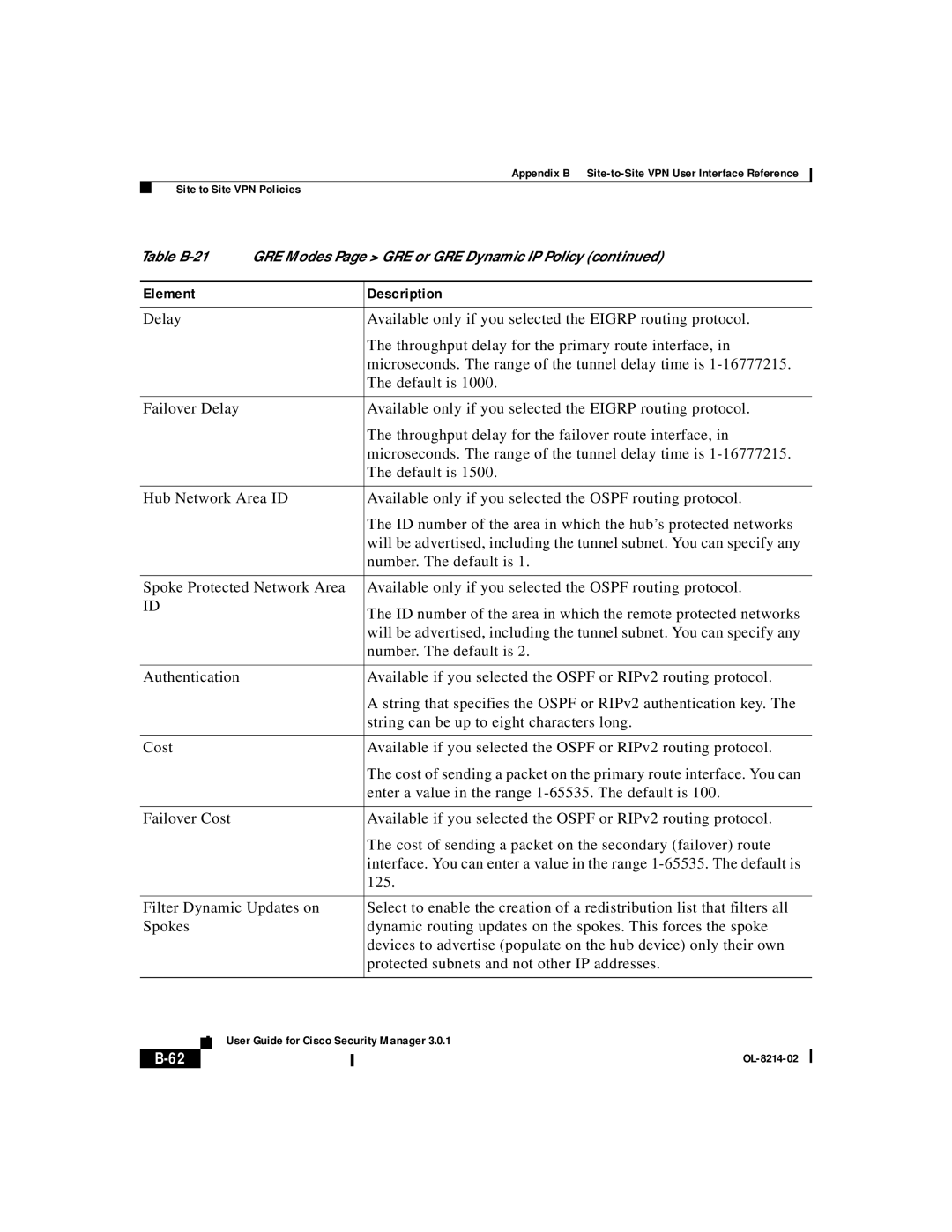
Appendix B
Site to Site VPN Policies
Table | GRE Modes Page > GRE or GRE Dynamic IP Policy (continued) | |||||
|
|
|
| |||
Element |
|
| Description | |||
|
|
|
| |||
Delay |
|
| Available only if you selected the EIGRP routing protocol. | |||
|
|
|
|
| The throughput delay for the primary route interface, in | |
|
|
|
|
| microseconds. The range of the tunnel delay time is | |
|
|
|
|
| The default is 1000. | |
|
|
|
| |||
Failover Delay |
|
| Available only if you selected the EIGRP routing protocol. | |||
|
|
|
|
| The throughput delay for the failover route interface, in | |
|
|
|
|
| microseconds. The range of the tunnel delay time is | |
|
|
|
|
| The default is 1500. | |
|
|
| ||||
Hub Network Area ID |
| Available only if you selected the OSPF routing protocol. | ||||
|
|
|
|
| The ID number of the area in which the hub’s protected networks | |
|
|
|
|
| will be advertised, including the tunnel subnet. You can specify any | |
|
|
|
|
| number. The default is 1. | |
|
|
| ||||
Spoke Protected Network Area |
| Available only if you selected the OSPF routing protocol. | ||||
ID |
|
| The ID number of the area in which the remote protected networks | |||
|
|
|
|
| ||
|
|
|
|
| will be advertised, including the tunnel subnet. You can specify any | |
|
|
|
|
| number. The default is 2. | |
|
|
|
| |||
Authentication |
|
| Available if you selected the OSPF or RIPv2 routing protocol. | |||
|
|
|
|
| A string that specifies the OSPF or RIPv2 authentication key. The | |
|
|
|
|
| string can be up to eight characters long. | |
|
|
|
| |||
Cost |
|
| Available if you selected the OSPF or RIPv2 routing protocol. | |||
|
|
|
|
| The cost of sending a packet on the primary route interface. You can | |
|
|
|
|
| enter a value in the range | |
|
|
|
| |||
Failover Cost |
|
| Available if you selected the OSPF or RIPv2 routing protocol. | |||
|
|
|
|
| The cost of sending a packet on the secondary (failover) route | |
|
|
|
|
| interface. You can enter a value in the range | |
|
|
|
|
| 125. |
|
|
|
| ||||
Filter Dynamic Updates on |
| Select to enable the creation of a redistribution list that filters all | ||||
Spokes |
|
| dynamic routing updates on the spokes. This forces the spoke | |||
|
|
|
|
| devices to advertise (populate on the hub device) only their own | |
|
|
|
|
| protected subnets and not other IP addresses. | |
|
|
|
| |||
|
| User Guide for Cisco Security Manager 3.0.1 | ||||
|
| |||||
|
|
|
|
|
| |
|
|
|
| |||
|
|
|
|
|
|
|
